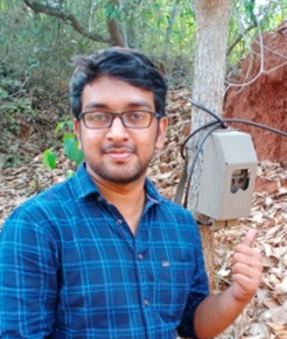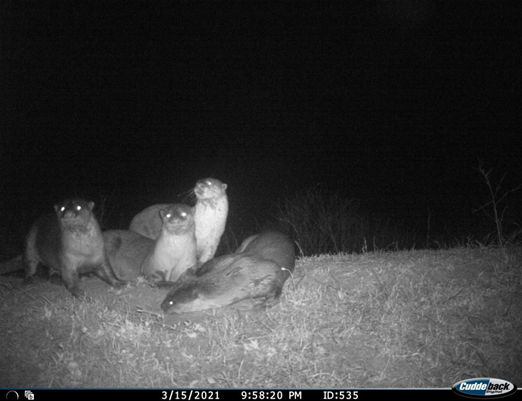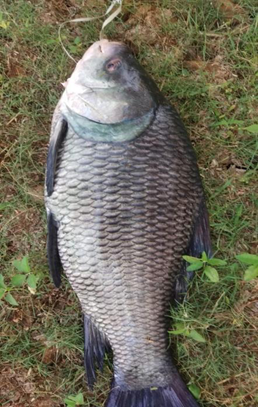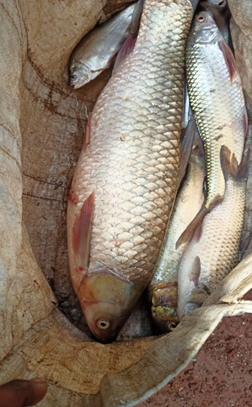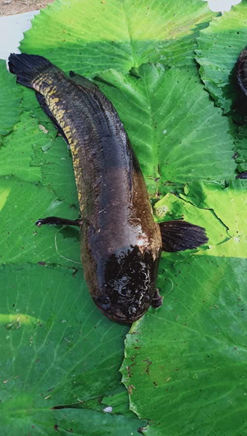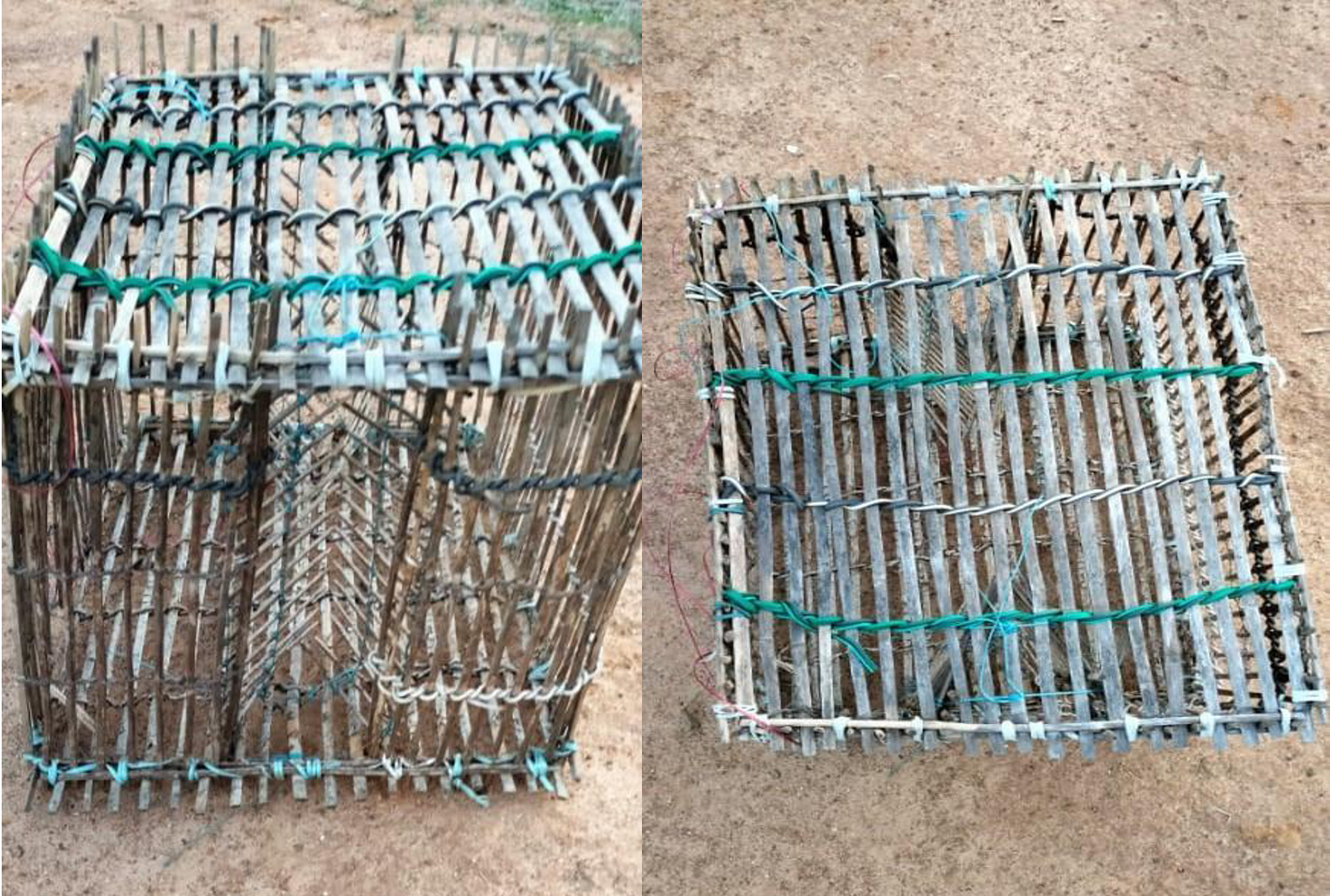IUCN/SSC Otter Specialist Group Bulletin

©IUCN/SCC Otter Specialist Group
Volume 39 Issue 1 (February 2022)
Citation: Tamarapalli, S.C.P., and Kolipaka, S. (2022). Smooth-Coated Otter Lutrogale perspicillata (Geoffroy, 1826) in the Urban Landscape of Visakhapatnam, Andhra Pradesh, India. IUCN Otter Spec. Group Bull. 39 (1): 22 - 28
Smooth-Coated Otter Lutrogale perspicillata (Geoffroy, 1826) in the Urban Landscape of Visakhapatnam, Andhra Pradesh, India
Sri Chakra Pranav Tamarapalli1*, and Shekhar Kolipaka2*
1Lead Wildlife Conservationist, East Coast Conservation Team, T11, Bobby NKM Apartments, PM Palem, Visakhapatnam, Andhra Pradesh-530041, India.
2Leo Foundation, The Netherlands www.leofoundation.org
*Corresponding Author Email: pranav.cherry@gmail.com
(Received 3rd June 2021, accepted 7th August 2021)
Abstract:The Smooth-coated otter, for the first time, is photographed in the Kondakarla Ava (Ava means lake) located within the urban landscape of Visakhapatnam district, Andhra Pradesh, India. In the Ava, otter-human relations, especially with the local fishing community, are strained with conflicts. Otters feed on commercially farmed and valuable wild fish in the Ava, such as snakehead fish, carp, catfish, and damage fish traps. The perceived financial loss of fish and the damage to equipment anger the fishermen, and they retaliate by opportunistically killing otters and the pups. Despite human retaliation, otters continue to survive in the human-dominated wetland ecosystem of Vizag. Their resilience and survival ability posts a solid case to support the conservation prospects of the species within this rapidly developing and proposed metropolitan region of Visakhapatnam.
Future investigations to support effective otter conservation planning in the Visakhapatnam district should include 1) Inter-connectivity of the various local streams and water bodies and if otter movement across the larger landscape is supported. 2) Investigate the human-dimension aspect, such as local practices of local communities using the streams and water bodies and their impact on wetlands and local fauna, and understanding wildlife conflicts.
Keywords: Kondakarla Ava, human-dominated, Visakhapatnam, urban wildlife, Vizag
INTRODUCTION
The Smooth-coated otter (Lutrogale perspicillata) inhabits wetlands such as rivers, lakes, estuaries and mangroves of south and south-east Asia (de Silva et al, 2015).
In the Indian subcontinent, the Smooth Coated Otter has a wide distribution within India, Pakistan, along the Terai of Nepal, along the Indus river, in the lower parts of Bhutan, Bangladesh and Myanmar. In Andhra Pradesh state on India’s east coast, the smooth-coated otter is found in the Krishna and Godavari river basins and several wetlands (Nagulu et al., 1998).
In the Indian subcontinent, the Smooth Coated Otter has a wide distribution within India, Pakistan, along the Terai of Nepal, along the Indus River, in the lower parts of Bhutan, Bangladesh and Myanmar. In Andhra Pradesh state on India’s east coast, the smooth-coated otter is found in the Krishna and Godavari river basins and several wetlands (Nagulu et al., 1998).
The Smooth-Coated Otter is a vulnerable species in the IUCN red list (de Silva et al., 2015). Primarily, the vulnerability to the otter across their range is from retaliatory killing by local fishermen because it competes for fish or steals fish from nets. Further, otter pelts are highly valued, and they are trafficked. Their wetland habitat is also critical for human survival and is always at risk of degradation.
Several streams, lakes, and marshes abound in the coastal city Visakhapatnam (Vizag from here onward) of Andhra Pradesh. There is evidence that the local wetlands supported several habitat specialists such as the otter, fishing cat, and tens of wetland birds and reptiles from historical times. While there are records of the otter in Vizag, over the last 3 decades, the city has expanded and changed into a vast and heavily urbanized human-dominated landscape. To understand the survival status of local wildlife in the urban wetlands, we started surveying Kondakarla Ava, the biggest freshwater lake in the city, in January 2021.
STUDY AREA AND METHODS
A group of four people walked human and animal trails in the Kondakarla Ava area (Fig. 1). The goal was to find evidence of otter tracks and signs. At promising locations, Cuddeback digital camera traps were installed to capture otter presence.
In addition, to understand the local perception of the otter, we engaged local fishers in informal chats over 2 months. We used semi-structured questions, ensured that the information generated was incorporated into subsequent queries, and adapted our interviews. This method allowed us to cross-check the reliability of the responses, consistency of answers and developed deeper insights into human-otter interactions.
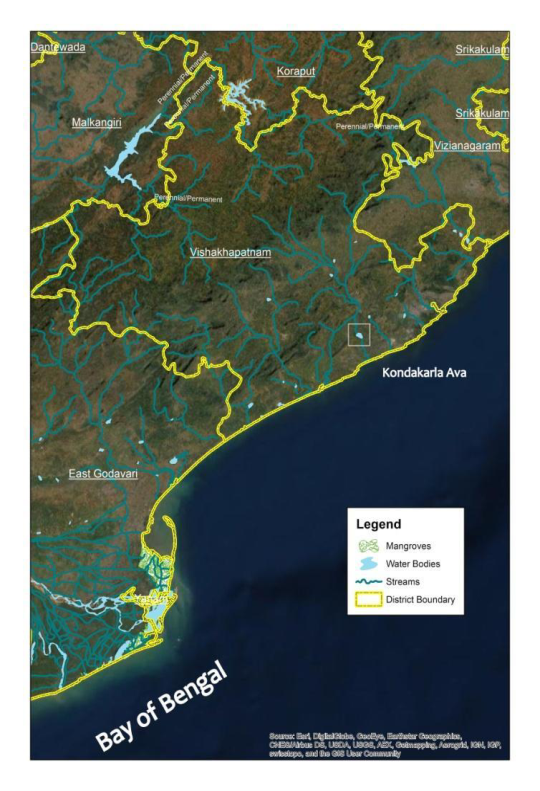
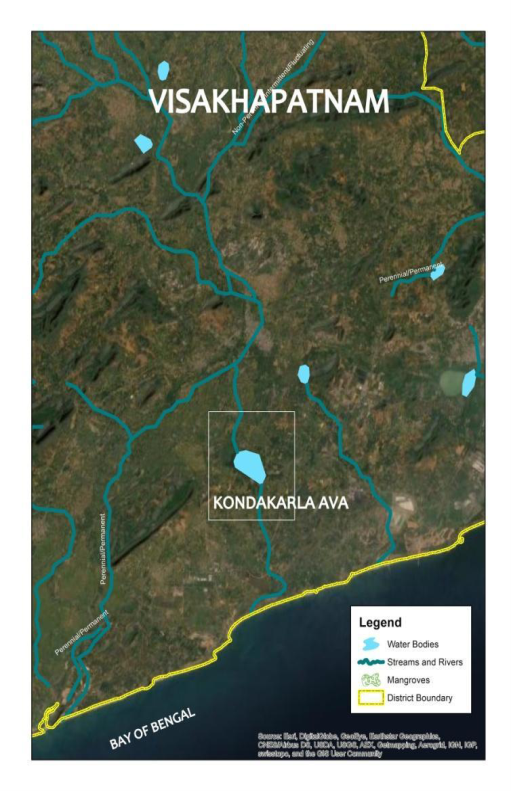
RESULTS AND DISCUSSION
Camera Trap Survey Findings
A small group of four smooth-coated otters were photographed for the first time (Fig2). Otters avoided areas where cameras with white flash functioned and could only be photographed in black flash camera traps. They may have seen the camera flash go on and possibly avoided using those trails.
Besides otters, domestic cats, village dogs and palm civets, and people were also photographed. The spoor of fishing cat, jungle cat, palm civet, small Indian civet, grey mongoose, small Indian mongoose was also found on the trails around Kondakarla Ava. A recently abandoned otter holt with fresh spraint was observed on 28th January 2021. The waters recede in the lake area at this time of the year, and human activity increases. Grass harvesting, fishers wading through shallow water, dog movement all could have contributed to the disturbance.
Comprehensive identification of birds revealed the presence of wetland specialists like coot, moorhen, jacanas, lesser whistling duck, oriental darter, Asian openbill stork, and several seasonal migrants. Woodland and shrubland species such as grey hornbills, painted spurfowl, barred button quails are found around the lake.
Fishermen's Views about Otter-Human Interactions
In the Telugu speaking areas of Andhra, including Visakhapatnam, the otter is locally referred to as Yeti kukka (water dog) and neeti pilli (water cat). Local communities living around Kondakarla Ava do not eat otter flesh. However, in other parts of Andhra Pradesh, otters are opportunistically eaten.
Local communities admire the otter for its swimming adeptness, mastery at outsmarting the fishers and stealing from their traps. Fishers believe that the otter cannot be killed and does not die in a story bound way. We did not find any evidence of people worshipping the otter in the local area during our interactions. The Kondakarla Ava itself is seen as a sacred lake. A water goddess representing the lake is worshipped during March and other local spirit deities Yellaramma and Nukambika.
Knowledge
Local fishers did not have very accurate knowledge of otter behaviour or their ecology. Many myths and beliefs surround their descriptions of the otter. According to interviewed local fishermen, otters are residents. This response was consistent. According to the interviewees, otter activity is more at night and in the crepuscular hours (dawn and dusk). All the otter pictures we captured are night-time and corroborates with local information. With dogs and human activity high in the area during the day, otter activity in Kondakarla Ava is primarily nocturnal and consistent with the activity of wildlife reported in other similar human-dominated sites worldwide, for example, Gaynor et al., 2018.
Fish Losses
Fishers release high-value fish seed in Kondakarla Ava, and fishing is their primary source of income (Fig. 3. 4 and 5). Birds, snakes, reptiles and mammals, preyed on fish at different fish-life stages and reduced stocks. To protect personal financial interests, fishers are vigilant against all these threats.
Fishers revealed that otters damage their fishing gear and steal fish. Local fishers use handmade bamboo traps to catch fishes like Snakehead murrel (Channa striata), Rohu (Labeo rohita), grass carp (Ctenopharyngodon idella), Catla (Labeo catla) and other freshwater fishes. It took them several man-days to build their intricate bamboo, coconut leaf and nylon traps (Figure 6). When wildlife damaged traps, it aroused tempers and upset fishers retaliated antagonistically on potentially threatening wildlife, including otters.
The scale and exact extent of losses and the actual species responsible is not clear in this assessment. Otters were readily blamed for fish losses, and people tried to kill them occasionally. These existing conflicts need more detailed qualitative and quantitative investigation. We plan to investigate these aspects before any conservation interventions. Fishers’ future expectations of Kondakarla Ava and coexistence prospects also need further understanding.
Potential landscape-level connectivity
The Sarada river is connected to the lake through a canal. Tracks and spraints are observed at several locations along the canal, suggesting that the otters may be moving beyond the Ava and using other water bodies in the district (Fig. 1). If the otters in Visakhapatnam could also be moving far and interacting with populations in East Godavari and those in Vizianagaram and Srikakulam districts needs understanding too. As a next step, focused surveys on the otter's habitat connectivity and threats to otters along the water networks will be crucial to conservation planning purposes.
Acknowledgements: We thank the Green Paw Conservation project and Green Waves environmental solutions for their support and collaboration. We thank our teammates Hari Krishna Varma and Honey Seles for field work support. We thank AP Forest Department and, in particular, Sri Anant Shankar IFS, Charlene Lopes and local fishers for their cooperation.
REFERENCES
Bhagyasree, V., Rathod, V.N., Selvam, C. (2020). A checklist of birds from Kondakarla Ava, a freshwater lake in Visakhapatnam, Andhra Pradesh, India. Bird-O-Soar #59 in: Zoo’t 35(11): 6-15. Available from https://zoosprint.zooreach.org/index.php/zp/article/view/7149/6481
de Silva, P., Khan, W.A., Kanchanasaka, B., Reza Lubis, I., Feeroz, M.M., Al-Sheikhly, O.F. (2015). Lutrogale perspicillata. The IUCN Red List of Threatened Species 2015: e.T12427A21934884.
Gaynor, K., Hojnowski, C., Carter, N., Brashares, J. (2018). The influence of human disturbance on wildlife nocturnality. Science. 360. 1232-1235. DOI: https://doi.org/10.1126/science.aar7121
Khan, M.S., Dimri, N.K., Nawab, A., Ilyas, O., Gautam, P. (2014). Habitat use and conservation status of Smooth-coated otters Lutrogale perspicillata in Upper Gangetic Basin, India. Ani.Biodiv. Conserv. 37: 69-76.
Nagulu, V., Rao, V.V., Satyanarayana, D., Srinivasulu, C. 1998. Otter records and otter conservation perspectives in Andhra Pradesh, India. IUCN Otter Spec. Group Bull. 15(1): 31–37 https://www.iucnosgbull.org/Volume15/Nagulu_et_al_1998.html
Résumé: Loutre à Pelage Lisse, Lutrogale perspicillata (Geoffroy, 1826) dans le Paysage Urbain de Visakhapatnam, Andhra Pradesh, India
Pour la première fois, une loutre à pelage lisse a été photographiée autour de Kondakarla Ava (Ava voulant dire lac), dans la zone urbaine du district de Visakhapatnam situé dans l'État d’Andhra Pradesh en Inde. Les relations entre les loutres et les humains autour de cet Ava sont conflictuelles, en particulier avec la communauté locale de pêcheurs. En effet, les loutres se nourrissent du précieux poisson d’e;levage comme le poisson à tête de serpent et ont aussi tendance à abîmer les pièges. La perte financière engendrée met les pêcheurs en colère, qui se vengent à l’occasion en tuant les loutrons ou en essayant de capturer les individus qu’ils aperçoivent. Un solide argumentaire sur l’importance de la conservation des espèces résilientes et spécialisées des zones humides, comme la loutre, à l’intérieur de la limite urbaine de la ville de Vizag est actuellement rassemblé. Les futures recherches visant à soutenir une planification efficace de la conservation des loutres dans le district de Visakhapatnam devraient inclure 1) l’interconnectivité des divers cours d’eau et plans d’eau de la zone et si les loutres se déplacent à travers l’ensemble du paysage 2) Enquêter sur la dimension humaine, comme l’utilisation des cours d’eau et points d’eau par les communautés locales, leur impact sur les zones humides et la biodiversité ou encore les conflits liés à la faune.
Revenez au dessus
Resumen: La Nutria Lisa Lutrogale perspicillata(Geoffroy, 1826) en el Paisaje Urbano de Visakhapatnam, Andhra Pradesh, India
Por primera vez, la nutria lisa es fotografiada en Kondakarla Ava (Ava significa lago) ubicado dentro del paisaje urbano del distrito de Visakhapatnam, Andhra Pradesh, India. En el Ava, las relaciones entre nutrias y humanos, especialmente con la comunidad pesquera local, están en tensión debido a los conflictos. Las nutrias se alimentan de peces criados comercialmente y con gran valor en el Aa, como el pez cabeza de serpiente, la carpa, bagres, y también dañan las trampas para peces. La pérdida financiera percibida y los daños al equipo enojan a los pescadores, que toman represalias matando de manera oportunista a las nutrias y sus cachorros. A pesar de estas represalias humanas, las nutrias continúan sobreviviendo en el ecosistema de humedales dominado por actividades antrópicas de Vizag. Ésta resiliencia y capacidad de supervivencia dá fundamento sólido a las perspectivas de poder conservar la especie en ésta región metropolitana de Visakhapatnam -que atraviesa un acelerado desarrollo.
Las investigaciones futuras para apoyar la planificación eficaz de la conservación de las nutrias en el distrito de Visakhapatnam deberían incluir 1) La interconexión de los diversos arroyos y cuerpos de agua locales, y si se facilita el movimiento de las nutrias a través del paisaje más amplio. 2) Investigar el aspecto de la dimensión humana, como las prácticas locales de las comunidades locales que utilizan los arroyos y cuerpos de agua y su impacto en los humedales y la fauna local, y comprender los conflictos con la vida silvestre.
Vuelva a la tapa
